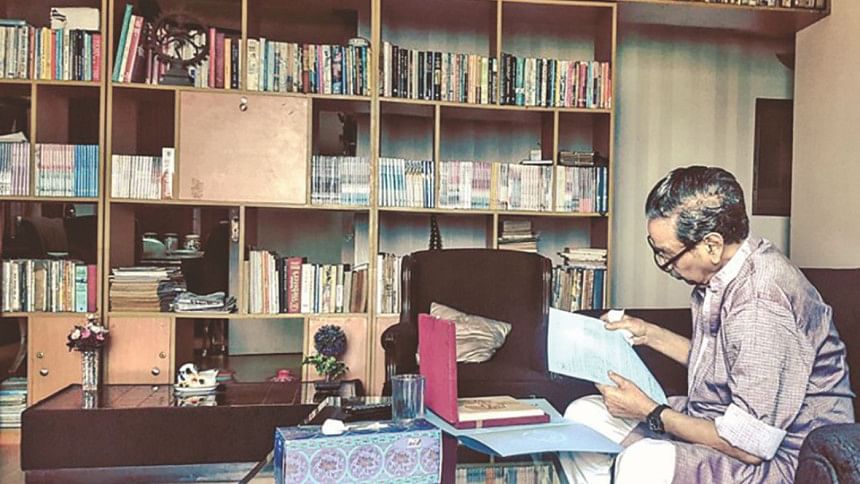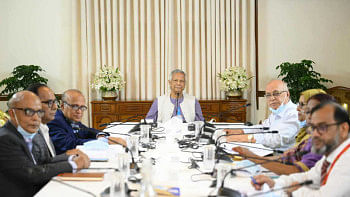Remembering Gazi Shahabuddin Ahmed

Gazi Shahabuddin Ahmed was a pioneer and a great human being. He still had much kindness left to give to the world when he suddenly left us on June 9, 2017.
Hailing from the renowned Gazi family, the descendant of Fazl Gazi—Zamindar of Bhawal Estate (now Gazipur, named after the family)—and one of the Baro Bhuiyas of Bengal, Gazi Shahabuddin Ahmed was born in Dhaka in 1939.
He was a quiet and unassuming person, never interested in the limelight. He found the pleasure in his life through the company of friends and family, by inspiring the young people to engage in literary pursuits, and giving them growth opportunities.
While studying in Notre Dame College, Gazi Shahabuddin started publishing and editing a literary-cultural magazine called Sachitra Shandhani. This magazine was the brainchild of a group of Dhaka-based young arts enthusiasts, led by him, and emerged as a movement of sorts. The aesthetes-led campaign was unlike any other.
From a very young age, Gazi Shahabuddin was a voracious reader. He would read whatever he could lay his hands on. Whenever possible, he would get books and magazines from abroad. Apart from reading books, he was interested in the aesthetics behind the publication, and wondered why we didn't have publications like that here.
So at 17, he took it upon himself to start a magazine himself. He gathered some friends and converted two rooms in the house into an office. However, it was easier said than done. The biggest challenge for the teenagers was finance, naturally. Initially, they started collecting funds from relatives. Later, they rented a cinema to show movies for money. Every day, they would go out with a microphone on a horse carriage to promote the special show. Eventually they collected enough funds. One thousand copies were printed for the first issue of the magazine. Next morning, all copies were sold out.
Hitting the market in 1956, this lavishly printed colour magazine would in later years be considered a turning point in the publication history of the country. It not only dedicated pages to literature, movies, humour and satire, but also played an important role in promoting women's empowerment, gender equality, child rights and other pertinent issues with its cover stories.
As a child, it was a wonderful experience for me to watch the magazine take shape from close quarters. I was enchanted by the processes of manual composition that used tiny cast metal alphabets, printing, and binding. That monotonous hum of the machines and the distinct scent of pasting gum and printing ink are still etched in my memory today.
Many renowned names of Bangla literature started their journey with Sachitra Shandhani. This monthly was witness to the birth of a new generation of creative people involved in different branches of the arts.
The early editorial team of Sachitra Shandhani included luminaries such as Qayyum Chowdhury, Zahir Raihan, Ataus Samad, Humayun Khan, and Sharfuddin Ahmed. The magazine ceased publication after an eventful 10-year run, but has had an impact that extended far beyond Bangladesh's independence.
In 1977, once again under his guidance, it was reborn as a weekly, kicking off a new journey as the mouthpiece of the literary minds of the newly independent country. He found himself with a new team of post-Liberation War poets, short story writers, and film society activists.
Some of the best literary works by Bangladesh's renowned writers have been published in the magazine, including Jahanara Imam's famous wartime diary Ekattorer Dinguli which was serialised. Afterwards, the issues of the series were compiled and published as a book from his publishing house Shondhani Prokashoni.
Shondhani Prokashoni also published works by many celebrated writers like Zahir Raihan, Shawkat Osman, Syed Shamsul Haque, Abdul Gaffar Chowdhury, Shamsur Rahman, Sayeed Atiqullah, Al Mahmood, Nirmalendu Gun, Mahadev Saha, Selina Hossain, Pranab Bhatta, and Sushanta Majumder.
From West Bengal, Sunil Gangopadhyay, Nabaneeta Dev Sen, Mahasweta Devi, and Sagarmoy Ghosh (editor of Desh) were frequent guests of Gazi Shahabuddin. In 1985, Sunil Gangopadhyay dedicated his book Bhalobasha Nao, Hariye Jeyona to him and his wife.
East Bengal in the 1950s and 1960s was a land of awakening, with its political dynamism and cultural-literary activities. Gazi Shahabuddin and his friends, ranging from progressive authors, critics, artists to filmmakers, helped build a cultural front that would later put up a strong resistance to the exploitative reign of the Pakistani rulers.
A social renaissance happens through the many multifaceted activities of many people. Even with their unique and significant contributions, not everyone comes to the spotlight. Gazi Shahabuddin was one such giant who, in his own unassuming way, played a remarkable role in this movement with his imagination, determination and creativity.
His dreams were sky high and his heart was big as the sea. He never cared much for worldly matters, but opened horizons for a whole generation. Throughout his life, he selflessly helped people and never asked for anything in return.
He might have not received the recognition that he deserved. However, we need to make sure that his dream of a progressive nation and an enlightened culture stays alive and future generations continue to thrive in literature.
Gazi Nafis Ahmed is the nephew of Late Gazi Shahabuddin Ahmed. He is a visual artist and fellow at the Center for the Study of Social Difference at Columbia University.





Comments